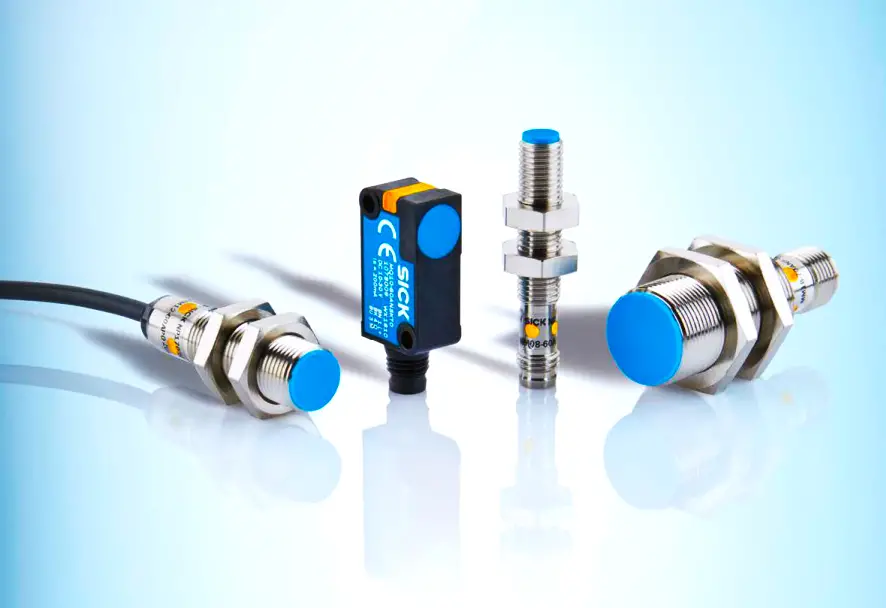In this article, we will learn the working principle & types of Magnetic Proximity Detectors (Sensors) used in industrial applications.

This sensor works on the Hall Effect principle, as demonstrated in the diagram, in which a potential voltage is provided across a hall element, such as a tin hall element. As a result, positive and negative charges start to flow.
When a magnet is located close to the hall element material, negative and positive charges accumulate at the opposite ends of the plate.
When we check the voltage across it, we have a minimal voltage in microvolts. An amplifier is generally used to enhance this. When the item is brought closer, a greater potential across the plates is formed, and when it reaches the threshold, the output is set to high.
Other mechanisms used in magnetic proximity sensors include dynamic reluctance, reed switches, GMR (Giant Magneto-Resistive effect), and inductive coupling.
The characteristics of magnetic proximity sensors are as follows.
The magnetic proximity sensors’ sample specifications are as follows.
| Sensing distance in mm | Up to 80mm |
| Vibration tolerant | Excellent |
| Sensitivity | Susceptible to magnetic interference |
| Sensing object material | The object should be of Magnetic material only |
| Cost | Cheap |
| Size | Small |
| Application | Used to detect the open or closed status of windows, gates, and doors. Used in the food industry. |
The types of magnetic proximity sensors are as follows.
The presence of a permanent magnet triggers these sensors, and their functioning is dependent on the utilization of a reed contact. The reed contact may have usually two reluctance ferromagnetic leads which are encapsulated in glass bulbs that comprise inert gas.
Because of magnetic induction, the reeds would be attracted in the presence of a magnetic field, resulting in electrical contact. The contacts of the reed switch are ordinarily open and will close if a magnetic field is present.
The number and nature of magnet required would be determined by the type of reed switch and how it is designed. The distance between the magnet and the switch is essential; if the distance is large, a powerful magnet is necessary to interact with the switch.
We must ensure that there are no interfering magnetic fields around the sensor while installing a reed switch. Hence, in this event, we must verify that the proximity sensor is protected in agreement with this.
Reed switches are classified as
The advantages of the reed switch are as follows.
Coils, a magneto-elastic core, and a measuring rod form such a kind of sensor. The shift in the position of the detecting shaft of this sensor would cause stress on the sensitive core.
The permeability of the core material would change with stress, affecting the inductance of the winding looped around the core, which is a function of shaft position.
When a material is considered to have magneto-resistivity, it implies that it can alter its corrosion resistance when subjected to a magnetic field. As a consequence, this form of position sensor would evaluate the magneto-resistive effect of the material when subjected to a magnetic field.
To detect position, we can attach the sensor to an angular or linear moving object while keeping the complimentary sensor or magnet immobile. The magneto-resistive feature may exist in high-carbon steel and can be employed to produce a resistive element as a thin strip.
The major difference between this sensor and an inductive proximity sensor is that it comprises a built-in oscillator. The oscillating coil is not of a half-shell core design, generating a magnetic field directed onwards, but a coil with a closed shell construction, such as a shielded ferrite core. When a permanent magnet is used, the core material of the oscillator core becomes saturated, creating a vibration in the proximity sensor’s oscillator current.
A trigger state examines the change and transforms it into a predetermined output signal. This sort of proximity sensor would only detect magnetic fields and would not detect metallic things.
A Hall Effect detector is a non-contact position detector composed of a permanent magnet and a Hall Effect sensor IC. The Hall Effect is the result of an interaction between a moving electric carrier and an external magnetic field.
The magnetic field impacts the output of the hall sensor, which may be employed for proximity switching, position, and speed detection. When a permanent magnet gets close to the hall sensor IC, it detects a change in the magnetic field and creates an electric signal. This signal is then amplified and rectified to control the switch’s output signal.
We can measure linear distances with precision and dependability using LVDT. In order to obtain position information, the ferrous core will be hooked to the moving portion of the machine.
An electrical sensor whose output is proportional to the location of a moving magnetic core and gives a linear electrical output equivalent to the position of a moveable ferrous core.
The benefits of magnetic proximity sensors are as follows.
The applications of magnetic proximity sensors are as follows.
Read Next:
Rotating equipment packages such as pumps, compressors, turbines need the lube oil consoles for their…
This article explains how to blink lights in ladder logic with a detailed explanation video…
In this article, a simple example will teach you the conversion from Boolean algebra to…
In this article, you will learn the PLC cooking timer example for kitchen automation using…
Learn an example PLC program to control a pump based on level sensors using ladder…
In the PLC timer application for security camera recording, when motion is detected then camera…